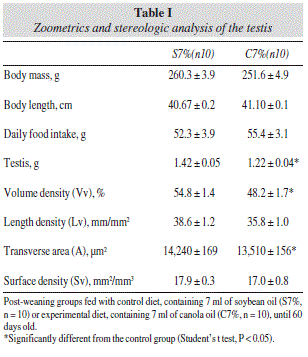Mi SciELO
Servicios Personalizados
Revista
Articulo
Indicadores
-
 Citado por SciELO
Citado por SciELO -
 Accesos
Accesos
Links relacionados
-
 Citado por Google
Citado por Google -
 Similares en
SciELO
Similares en
SciELO -
 Similares en Google
Similares en Google
Compartir
Nutrición Hospitalaria
versión On-line ISSN 1699-5198versión impresa ISSN 0212-1611
Nutr. Hosp. vol.27 no.5 Madrid sep./oct. 2012
https://dx.doi.org/10.3305/nh.2012.27.5.5822
Effects of soybean or canola oil intake on seminiferous tubules structure in young rats
Efecto de la ingesta del aceite de soja o canola en la estructura de los túbulos seminíferos en ratas jóvenes
The prevalence of infertility is increasing in many countries. Some evidences consider that diet content may influence fertility.1 Among diet factors, the quantity and the kind of fat intake can contribute to spermatogenesis. The essential fatty acids, such as linoleic acid (LA) and alpha linolenic acid (ALA) are present in Sertoli and germ cells. Thus, the diet-lipid relation of LA and ALA can result in impaired fertility.2 The aim of study was to compare the effects of feeding young rats with diets containing high or low LA/ALA ratio, provided by soybean or canola oil, respectively, on seminiferous tubules structure.
After weaning, male Wistar rats were randomized to receive either a diet containing 7 ml/100 g of soybean (S7% control group, n = 10) or canola oil (C7% experimental group, n = 10). The diets have same amounts of the casein (20 g), cornstarch (53 g), sucrose (10 g), fiber (5 g), mineral (3.5 g) and vitamin mix (1 g), L-cystine (0.3 g) and choline bitartrate (0.25 g), per 100 g diet. In agreement with American Institute of Nutrition recommendations.3 After 39 days of treatment, at 60-days-old, body mass and length were evaluated. Animals were sacrificed, the testis were dissected and weighed. For stereological evaluation, the testis were fixed in alcoholic Bouin solution and processed following the routine techniques for paraffin inclusion. Serial sections of 5 μm thick were stained with hematoxylin-eosin. The data were analyzed by Student's t test. Results are expressed as means ± SEM with significance level of P < 0-05.
The animals had similar body mass, length and daily food intake. Testis mass was 14% lower (P < 0-05) in C7% group than S7% group. Length density (Lv) and Surface density (Sv) did not differ. The C7% group showed significantly low Volume density (Vv, -12%) and Transverse area (A, -5%).

Changes in dietary polyunsaturated fatty acids are reflected in the composition of tissues, including testis cells. Okuyana et al.4 reported lower serum concentration of testosterone, in rats treated, during 84 days, with diet containing 12% canola oil. While Rotkiewicz et al.5 verified that rapeseed oil, rich in ALA, caused degeneration and necrosis of seminiferous tubules in rats treated during 24 months.
To our knowledge, this is the first experimental study that evaluates the effects of diet containing canola oil on the morphology of seminiferous tubules of young rats. The model suggests that LA/ALA ratio might modify the testicular physiology and it would be appropriate avoid an excessive dietary intake of ALA, with respect to LA.
A. Furriel Gomes de Almeida1, C. A. Soares da Costa2, E. Gaspar de Moura2,
C. Ferreira Farias Lancetta1 and C. C. Alves Nascimento-Saba2
1Morphology, Biomedical Institute. Fluminense Federal University. Niterói. Rio de Janeiro. Brazil
2Physiological Sciences. Institute of Biology Roberto Alcantara Gomes. State University of Rio de Janeiro. Rio de Janeiro. Brazil
References
1. Sharpe RM. Environmental/lifestyle effects on spermatogenesis. Phil Trans R Soc B 2010; 365: 1697-1712. [ Links ]
2. Wathes DC, Abayasekara DR, Aitken RJ. Polyunsaturated fatty acids in male and female reproduction. Biol Reprod 2007; 77:190-201. [ Links ]
3. Reeves PG. Components of the AIN-93 diets as improvements in the AIN-76A diet. J Nutr 1997; 127: 838-841. [ Links ]
4. Okuyama H, Ohara N, Tatematsu K, Fuma S, Nonogaki T, Yamada K. Testosterone-lowering activity of canola and hydrogenated soybean oil in the stroke-prone spontaneously hypertensive rat. J Toxicol Sci 2010; 35 (5): 743-747. [ Links ]
5. Rotkiewicz T, Bomba G, Falkowski J, Glogowski J, Kozera W, Kozlowski M. Studies on a long-term use of rapeseed products in diets for boars. Pathomorphological changes in the reproductive system, liver and thyroid gland. Reprod Nutr Dev 1997; 37: 675-690. [ Links ]
![]() Correspondence:
Correspondence:
Celly Cristina Alves Nascimento-Saba
Physiological Sciences
Institute of Biology Roberto Alcantara Gomes
State University of Rio de Janeiro
Av. 28 de setembro, 87, Vila Isabel
RJ 20551-030 Rio de Janeiro, RJ. Brasil
E-mail: cellysaba@gmail.com
Recibido: 23-II-2012
Aceptado: 11-IV-2012














